I competed at a Halloween barn event once with my horse Storm; a young dark bay thoroughbred.
The last class was a costume contest and this was my first time participating in one.
I excitedly decided to dress myself as a hippy and Storm as a hippy van. My costume idea required me to paint flowers and peace signs on him.
But can you paint on a horse? The answer is yes. You can paint on a horse.
However should you paint on your horse depends on your horse’s temperament and what kind of paints you have available.
I had to do some research into what paint was safe to use on horses, because I didn’t want to hurt Storm or cause a skin reaction.
So, whether you are painting a horse for a costume event, some bonding time, for an anatomy demonstration, or a parade, whatever the reason, definitely make sure that the paint is safe for horses.
Horses can be painted with many different kinds of paint. But you should always use water or milk-based products instead of chemically-based ones. The ingredients should not contain heavy metals or preservatives and should have a low level of VOCs, or “volatile organic compounds.”
Scroll down before FAQs for costume ideas!
Things To Think About When Painting Your Horse
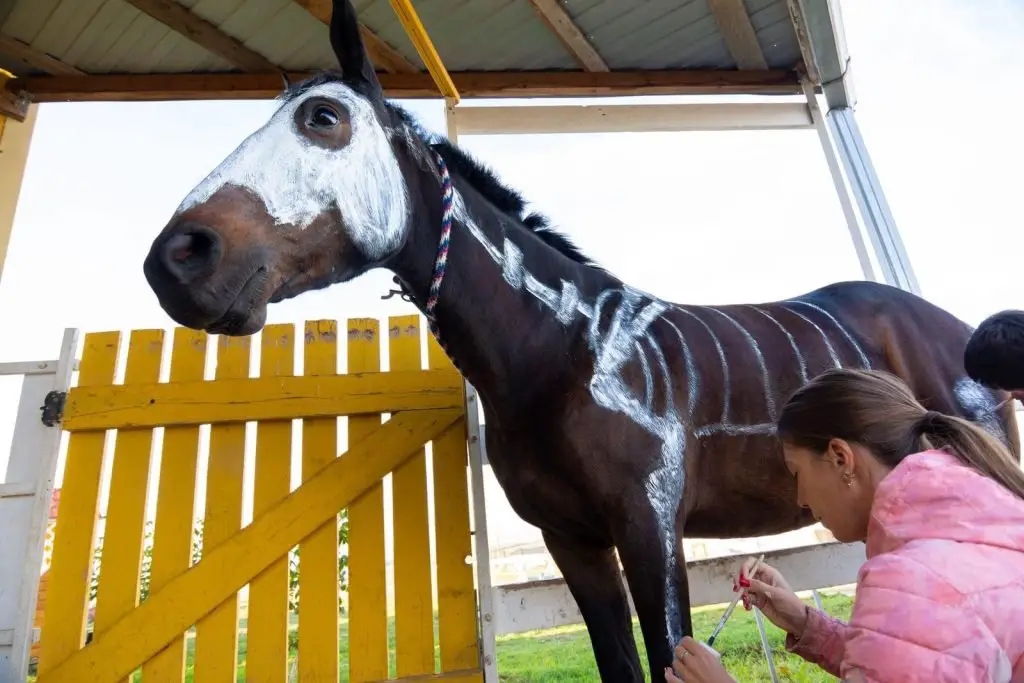
There are a few things you need to think about when setting out to paint your horse.
- What kind of paint you will use. Paints have different qualities, and some work better than others for painting horses.
- The tools you are going to use to apply the paint.
- How to apply the paint on different areas of your horse.
- What you want to paint on your horse and the colors you want to use.
- Staying safe while painting your horse.
- If your horse has the right temperament to be painted on.
- How to get the paint off when you are all done.
This blog post will focus on all the things you need to know when you are painting your horse.
This is going to be fun!
Why Do People Paint On Their Horses?
You may want to paint your horse for a parade or a costume competition. It may be that your horse’s full costume is being fully painted, or there may be an actual outfit with fabric along with painted details on your horse.
Painting your horse can be fun and is a unique way to spend some extra time with your horse. Horses typically like to be groomed, rubbed and stroked along their coat. It is almost like playing the friendly game from the Parelli 7 games, but with paint brushes.
Classes or clinics that are teaching anatomy or biomechanics sometimes paint the individual muscles on the horse or may paint a horse’s skeleton so you have a visual idea of how the horse’s muscles and skeleton move.
Sometimes summer camps or birthdays will have a horse paint party. This can be a bit more stressful for the horse. So temperament and paying attention to your horse’s stress signals is very important.
Does Your Horse Have The Right Temperament To Be Painted On
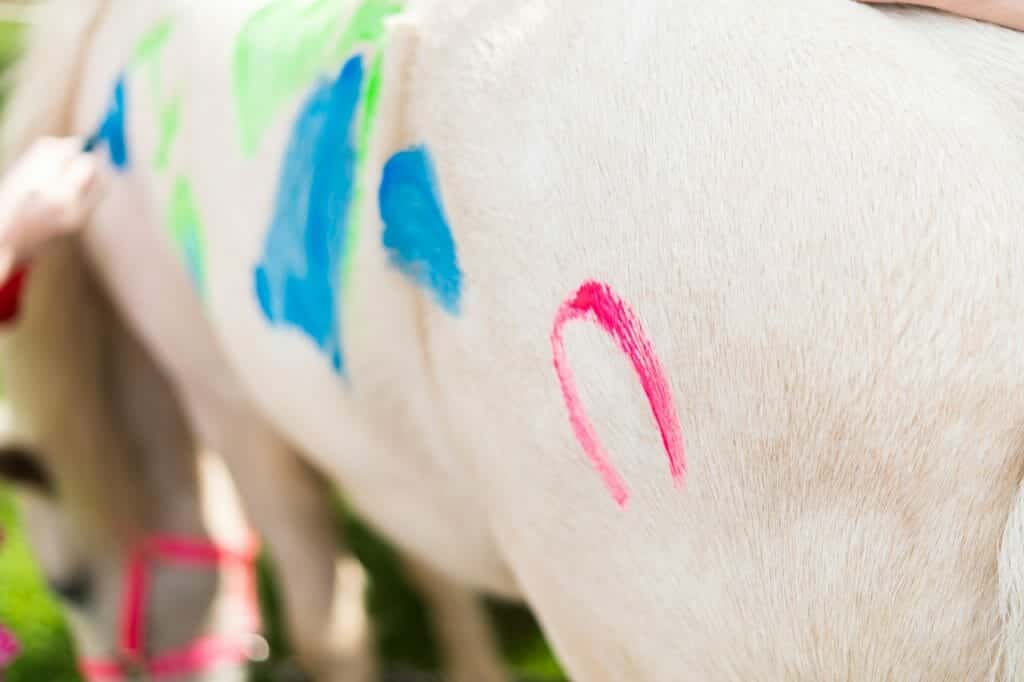
You want to make sure your horse is okay with being painted on.
So you will need to decide whether your horse has the right temperament to stand for being painted on. Painting is not the same thing as grooming nor bathing.
Your horse will need to stand still for long periods of time, some longer than others depending on the design and surface area you are painting. The more surface area and the more intricate the design the longer it will take.
Make sure your horse is comfortable and patient with standing for long periods of time.
Your horse will be feeling a different sensation from the normal grooming or bathing sensations. Some horses are very skin sensitive and easily irritated when being groomed. These kinds of horses may not like the feeling of being painted on.
Make sure your horse is comfortable with the sensation of being painted on.
If you are having your horse painted in a different environment or with numerous kids or people around they may be anxious or stressed. Some horses get stressed and the stress is held inwardly where they disassociate and it is hard to see outward signs of stress.
It is helpful to pay attention to the signs your horse is giving you and to give your horse breaks in a more relaxed, quiet area if they seem stressed or have to stand for long periods of time.
Make sure your horse is comfortable and not stressed in the environment you will be painting them in and give them breaks as needed.
A horse that is not an ideal candidate for being painted on:
- A high strung horse that gets stressed being tied up.
- It doesn’t like to stand for long.
- It gets easily tense.
- Is a spooky horse.
Some horses do love the attention, enjoy the painting process, hanging out and relaxing just as they would if they were being brushed, playing the “friendly game” or getting a gentle massage.
The main thing is to make sure your horse is relaxed, accepting of the process, and willing to just hang out without showing signs of stress.
What Are Horse-Safe Paints?
Safe paint you can use on horses would be non-toxic and easily washable, usually water-based, like tempera or chalk paint. Check that the label says “non-toxic” and “washable.” There are also “horse brand paints,” but you can use washable pet or human-safe paints too.
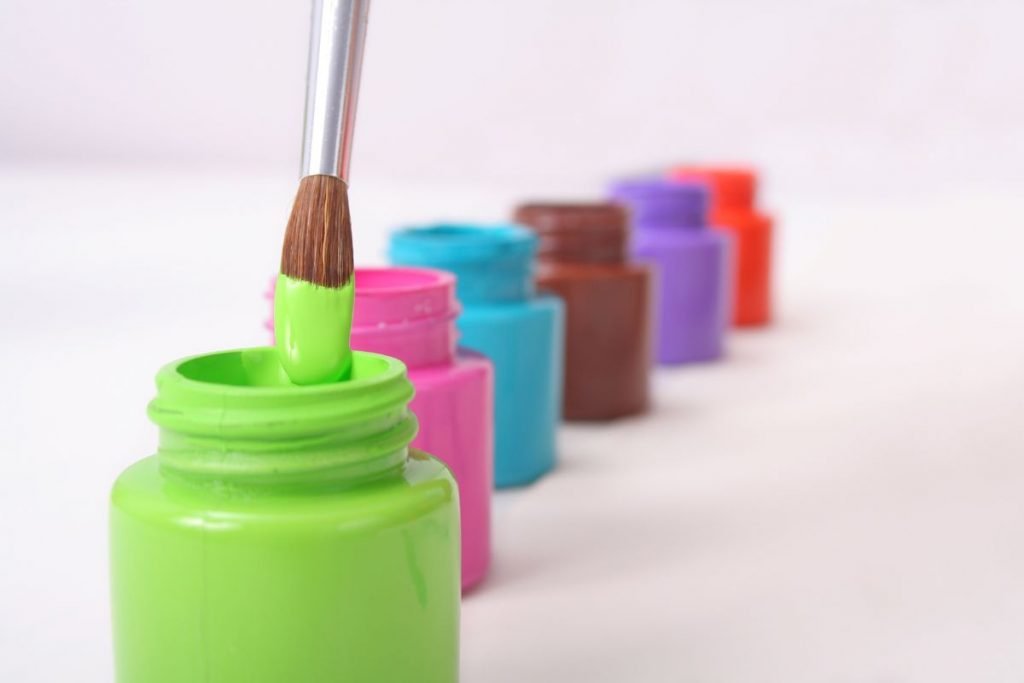
5 Types Of Paint Safe To Use On Your Horse
Here is a quick go to list of five paints that are horse approved. You may have some of these lying around the house, while others you will have to go out and purchase.
#1 Horse Brand Paints
If you are looking for a safe paint to use on horses, then a good paint to look for would be “horse brand paints.” These paints are specifically created and marketed for use on horses. They tend to be water-based, non-toxic, and easily washable.
A couple horse-brand paints would include:
I recommend Tail Tamer Pony Paint which has vibrant, bright colors but is safe and easily washable with soap and water.
Details Include:
- Liquid chalk paint
- Safe and nontoxic
- Can be removed easily by brushing off, hosing, or letting it naturally fade.
- You can use a paint brush or your fingers to apply it.
- Apply several coats for vibrant colors
#2. Pet Safe Paint
You have probably seen dogs go to the groomers or at least on video where they get their coats dyed with a bright pink, blue or purple color.
These are “pet safe” and another option for what you are able to use to paint on your horse.
There are several kinds of pet paint available, including:
- Temporary Pet Fur Coloring
- Washable Pet Fur Paint Dye Pens
- Hair Chalk Paint Pens
I recommend the Jim&Gloria Washable Pet Fur Paint Dye when you want to create designs but you are not trying to cover a large area. These are pens and come in an array of colors.
For painting a large surface, one paint I suggest is the Warren London Critter Color Temporary Pet Fur.
Details Include:
- Both are temporary and non-toxic
- The paint will fade away in a few days
- Wear gloves when applying Critter Color
- Critter Color available in 7 attractive colors.
- Jim&Gloria available in set of 12 colors
#3 Pet Color Hair Spray
Pet hair spray is another option for painting your horse. It is dye free and non-toxic. You apply by spraying but should consider wearing gloves because it can still get on your hands.
This spray is best for a wider area you want to color and not intricate designs. It will take several coats for a more vibrant color.
I recommend the Petway Petcare Pet Paint Spray. (Talk about a mouthful.)
Details Include:
- Temporary color
- Eco Friendly and Non-Toxic
- Propellant Free
- Can be used on any pets
- Comes in 9 different colors
- Washes off easily
#4 Kid Safe Paint
You know if the paint is safe for your kid to use then it should be safe to use on your horse as well.
These kinds of paints are easily available for purchase and you may already have them in your home. They are also easily washed off which is convenient when you want to get the paint off your horse.
Two types of kid-safe horse approved paints would include:
- Washable Paint
- Tempera Paint & Tempera Paint Sticks
I recommend the Colorations Tempera Paint over the washable because it is a bit more vibrant and though tempera is pretty easy to wash off, the washable paint can come off your horse a little too easily.
Details Include:
- Non-toxic
- Safe for kids and animals.
- It can be easily washed off with water and soap.
- It can be easily mixed with other colors.
- It comes in 11 bright colors.
#5 Human Grade Face & Body Paint
Any kind of paint that is safe to go on a human is generally safe to go on horses as well. This includes paints such as face paint and body paint.
These types of paints are easy to apply, they dry fairly quick and are pretty easy to get off.
I recommend the Moon Creations Face & Body Paint Set.
Details Include:
- Non flake long lasting formula
- Water-based
- Quick drying
- Easy to apply with paint brush, sponges or fingers
- Easy to remove with soap and water
- Available in 12 bright colors.
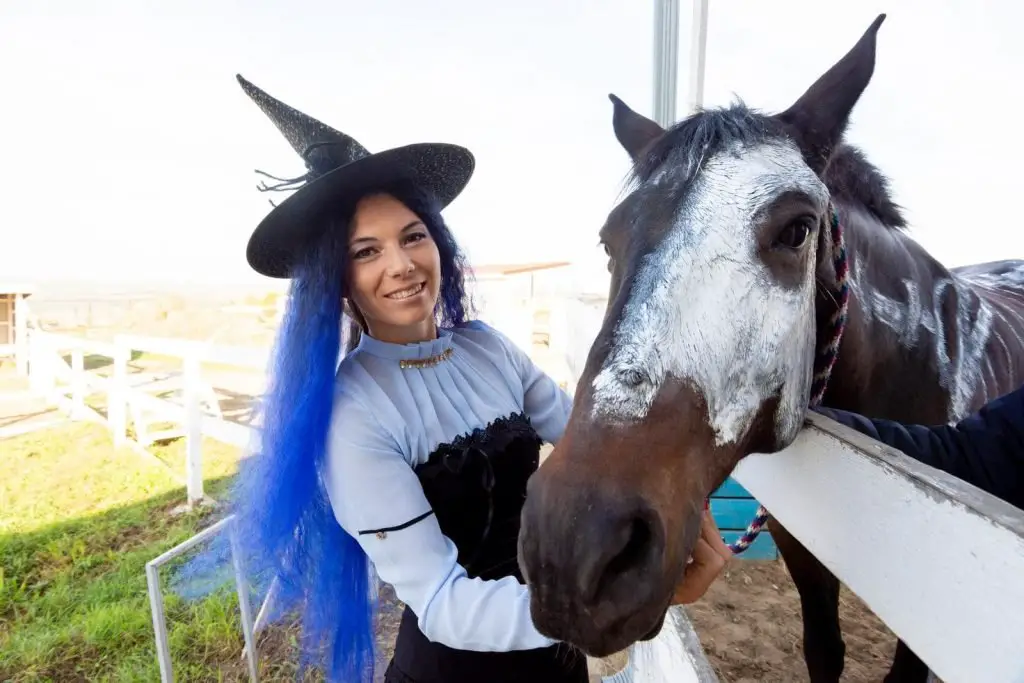
Avoid Using These Paints On Horses
Not every paint is safe or good to use on horses. Some of these paints may have harmful chemicals and toxins, or they may be difficult to wash off.
Check out this list of paints to avoid:
- Acrylic Paint– Though labeled non-toxic, there is possibility for toxins in certain colors which have been known to cause cancer. Also this paint not only cracks from movement when it dries, but also is difficult to get off.
- Colored Hoof Polish– There are paints on the market that are specifically colored hoof polish for your horses hooves. They are okay for hooves not for coat, mane or tail.
- Food Coloring– This paint is non-toxic and human grade, but it is not a good option because it can dye the horse’s coat and it can be very difficult to get the color out.
- Commercial Spray Paint– This paint is harmful if it comes in contact with your skin or if inhaled, consequently it will also be hazardous to your horse.
- Livestock Paint– Though yes you can use this paint on horses, it is very difficult to wash off and is weatherproof.
- Regular Paint– These often contain VOC’s a toxin which is released into the air and can cause eye irritation and harmful respiratory issues for your horse.
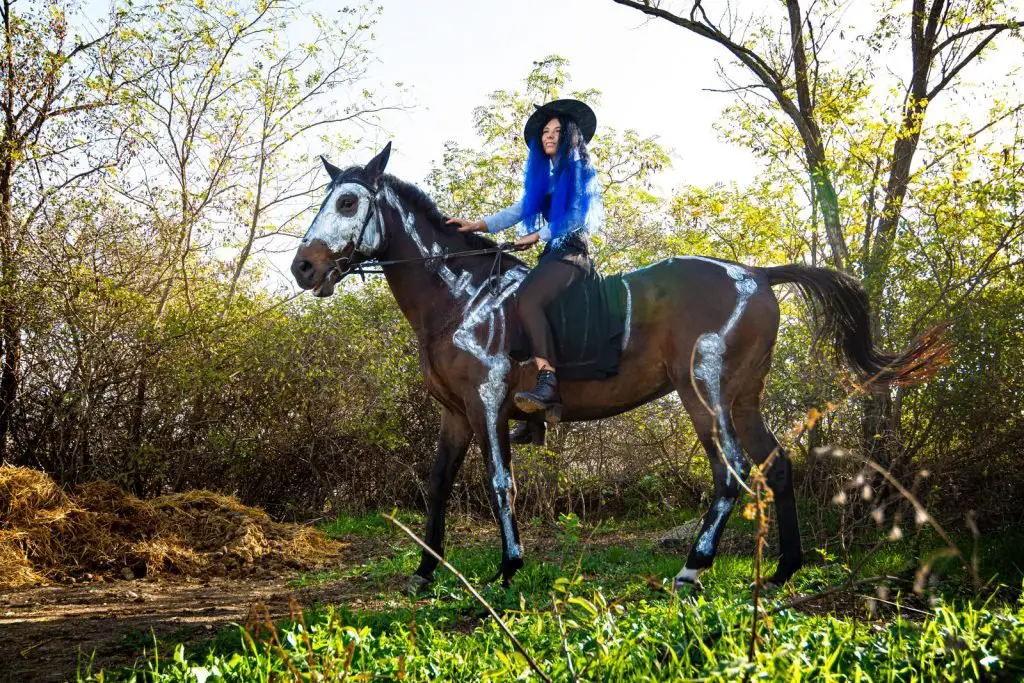
Best Paints To Use On Your Horse
The best paints to use on your horse will vary based on where you are painting on your horse, how many color options you want, the cost of the paint and how much paint you need.
Painting On Your Horse’s Coat
The best option for non-toxic, washable, cost-efficient paint with a vibrant range of colors for your horse’s coat would be tempera paints.
You can find these kinds of paints in large or smaller bottles.
Painting On Your Horse’s Mane & Tail
The best option for non-toxic washable paint for your horse’s mane and tail would be hair chalk.
There are chalk colored kits for kid’s hair as well as chalk paint for pets.
Painting On Your Horse’s Hooves
Painting on your horse’s hooves is different than what would go on their coat or mane, as it is the same material as our own finger nails. But hooves are porous and need to breathe, so you want a specific polish made for horse hooves.
The best option for painting on your horse’s hooves would be a colored hoof polish.
There are also other options for hooves, like pet nail polish pens, if you want to make designs on your horse’s hooves.
Hoof Polish
If you are daring, you may go for one of the bright solid colors on your horse’s hooves. But if you want something more subtle, you can do one coat of a glitter hoof polish, which will only give it a little sparkle, unless you add several coats.
There are also hoof stickers by Shires you can try out if that sounds like something more interesting or easier for you to apply than hoof polish.
- Twinkle Toes Glitter Hoof Polish– Multiple Colors Emerald Purple Copper
- Twinkle Toes Satin Hoof Polish– Multiple Colors Green Satin
- Schneider’s Horse 12oz Ultra Hoof Polish Remover
- Shires Brand Hoofies Horse Hoof Stickers– Multiple Colors
Tips For Using Glitter On Your Horse
- Most glitter products are safe to use, but make sure you check the label to make sure it is non-toxic.
- Be careful with loose glitter and avoid using this on your horse’s head or neck, where it can fall off into your horses hay, grain or water buckets.
- Don’t put glitter near any wounds.
- Be careful when using glitter around your horse’s mouth, nose and eyes.
Glitter Gel
Use glitter gel to add some glitz to your horse’s mane and tail. You can choose from quite a few different colors of glitter to match your horse’s theme.
- Tail Tamer Sparkle and Shine- Multiple Colors
- Twinkle Glitter Gel- Royal Blue Purple Gold Pink
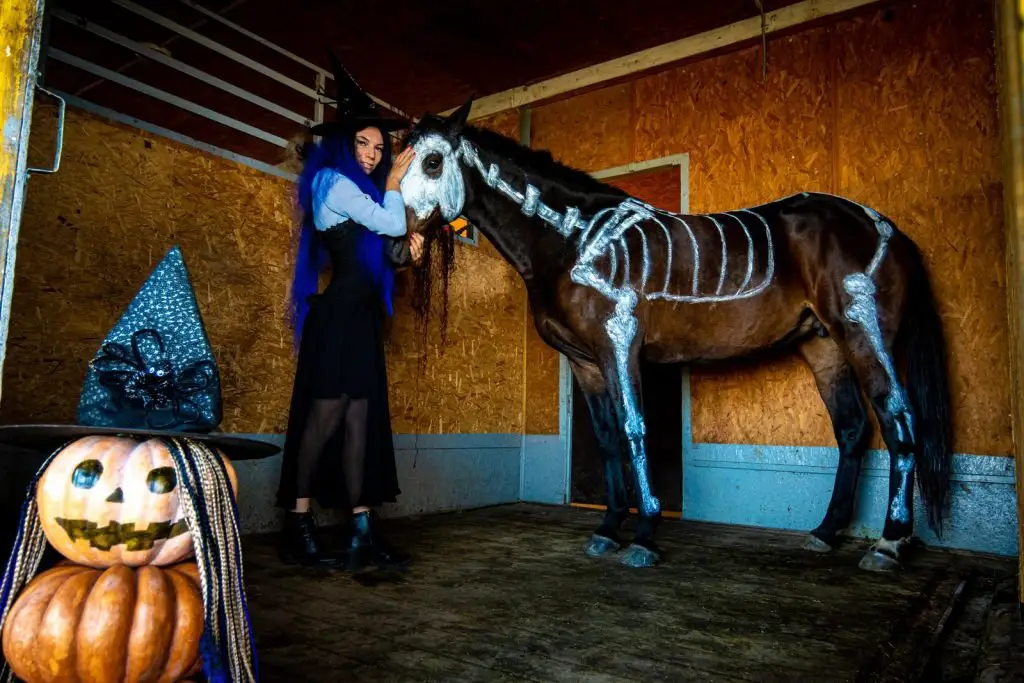
Best Tools To Apply Paint On Your Horse With
Once you pick a type of paint to use you will need to decide on what tools you need to apply the paint.
The tool can be as simple as a pair of gloves and you just use your hands and fingers.
However there are other options such as sponges, brushes and stencils.
Brushes For Applying Paint On Your Horse
For more intricate paint designs you will want to use smaller brushes like a # 12 round watercolor brush.
For bigger surface areas you will want to use a bigger wider paint brush.
Figure out the type of design you are going to do before you decide on brush size because you may also want to consider a mid sized brush.
Sponges For Applying Paint On Your Horse
Like the larger, wider paint brush sponges are also a good idea for when you are trying to cover more surface area.
Stencils For Applying Paint On Your Horse
Stencils are great for a quick design that looks nice with crisp edges. It is also handy if you happen to be artistically challenged.
Use a larger design with fewer small details if your audience is far away, whereas if they are closer, smaller detailed stencil designs should be fine.
You can purchase a stencil to use or print out a design online and cut out the outline of the stencil (where you want to color in.) However, if you print out the design, I suggest cardstock so that the paper is firmer and less likely to rip.
Airbrush Gun For Applying Paint On Your Horse
I wouldn’t go out of your way to get an airbrush gun unless you really want to and/or are artsy and want to go above and beyond.
The airbrush is a good tool for covering a larger area fairly quickly, as well as making shading, and highlight details.
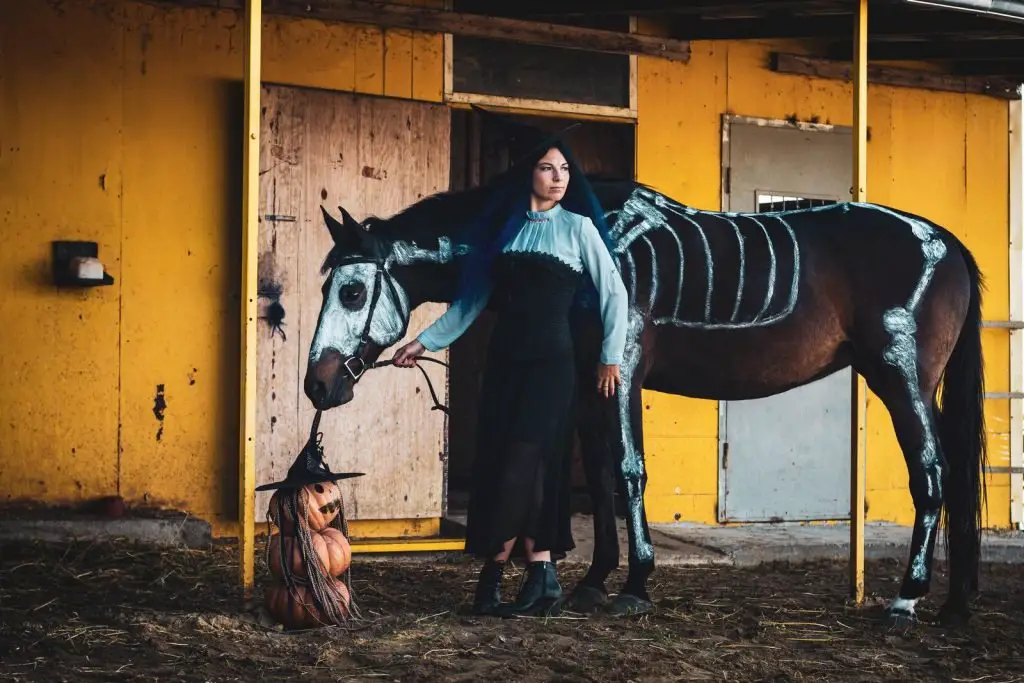
Safety Tips To Follow While Painting Your Horse
Safety should always be a concern when working with horses. You want to stay safe, keep your horse safe, and everyone around you safe.
So it is smart to become aware of some potential safety issues as well as to make sure you are following best safety practices for painting on your horse.
Here are some safety tips you should keep in mind while you paint your horse.
- A child should be supervised while painting their horse. They could easily get frustrated with the horse, not follow basic safety practices, not be paying attention to the horse’s behavior and children should always be supervised around horses.
- Make sure your horse is calm and comfortable and has the right temperament to be painted.
- Avoid painting near your horses eyes and be extra cautious with paint on the horses face when you are rinsing off the paint so it doesn’t get in your horses eyes or nose.
- Do gentle stroked with the paint brushes and don’t use spray cans if your horse gets startled by sprays.
- Make sure the place you are setting up to paint your horse is a relaxed atmosphere without lots of buzz and traffic. This way your horse won’t be as distracted and can have space to relax.
- Make sure the area you are having your horse stand for painting is clear of clutter that you or your horse could trip over or bang into.
- Make sure you are aware of your horse and your surroundings while you are painting. You might get so into painting that you don’t pay attention. If your horse gets scared or nervous, someone could get hurt if you don’t pay attention.
- Double check paint is non-toxic and washable.
- Follow basic horse safety practices you would normally when working with a horse.
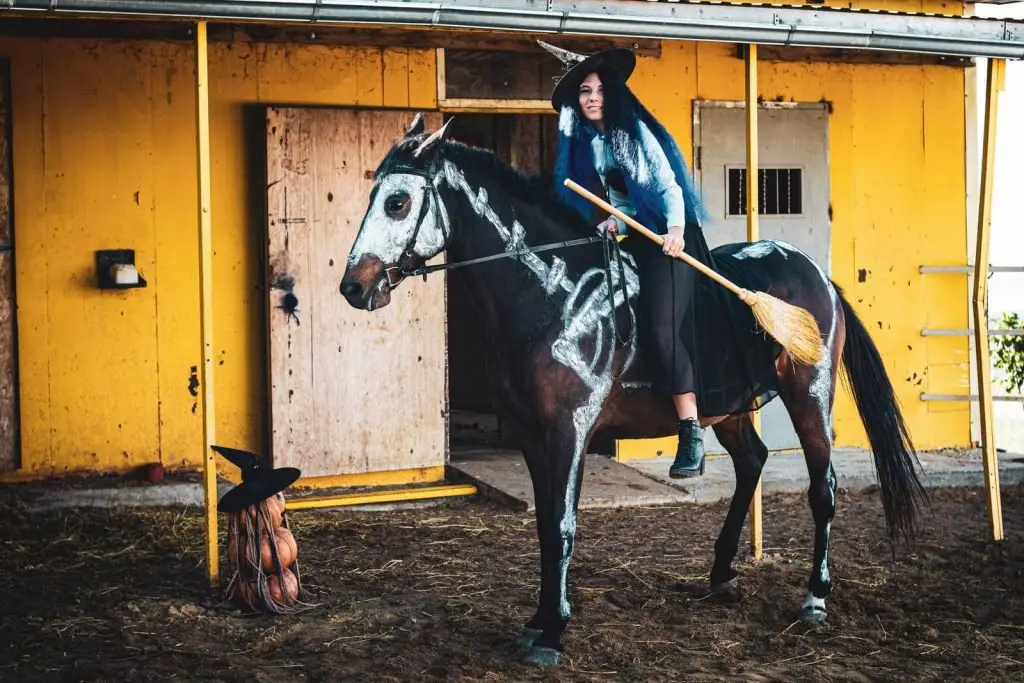
What Colors To Paint On Your Horse?
When you are trying to figure out what color to paint on your horse it may be dependent on the design you want to do. However certain colors will come out more clear on certain horse coat colors.
You can also do a color test before you decide on colors to see what colors show up best on your horse’s coat.
Paint Colors For Dark Horses
For a dark colored horse paints that will be more clear will be light colors, such as white and pastel like colors.
Paint Colors For Light Horses
For light-colored horses, the paint will show up better if they are more vibrant or dark, such as black.
However, white and grey colored horses can have most colors show up well on their coats aside from white or very light pastel coloring.
Prepping Your Horse To Be Painted
There are a few tips to follow to prepare your horse to be painted.
- Draw your horse on a piece of paper with the design and colors you are planning to try to paint on your horse. You can also use a photograph of a horse that is already painted if you are trying to copy the look. Or you can just be spontaneous and make it up as you go.
- You don’t need to bathe your horse unless they are really dirty. They shouldn’t be covered in dirt. If you paint a dirty horse, the paint will go on the dirt and if the dirt falls off the paint will go off with it.
- Give your horse a good grooming before painting and use a towel to do a quick dry wipe over the horse to get the excess dust.
- If you are painting your horses hooves make sure you get all the dirt off the hooves as well and sweep up the floor around your horse.
- If your horse has a very long coat the paint will be more difficult to apply and not show up as well. So clipping the coat would be a good idea. The shorter the coat your horse has the better the results will be as the paint will stick better.
- Spray the area with fly spray if there are a lot of flies but not the areas where you will be painting on your horse.
- Braid your horse’s mane and tail out of the way so they don’t get paint on them in those areas.
- Place the paints away from the horse to avoid it knocking them down.
- Wear safe footwear, clothes you don’t care to get paint on and gloves to keep your hands from getting paint all over them.
Fun Ideas For Painting Your Horse
There are many fun designs you can do when painting your horse. Whatever design you decide on, make sure the paint color will show up on your horse’s coat, you have the right application tools, and you have a photo or a drawing of what it is you want to design on your horse.
Here are some fun ideas for painting your horse.
- Dragon
- Skeleton
- Muscles
- Hippie designs
- Dragon
- Zebra
- Leopard
- Tiger
- Giraffe
- Cow
- Another color
- Stencil design on hindquarters or shoulder
- Pegasus
- Paint Hooves
How To Remove Paint From Your Horse
It is pretty easy to remove the paint from your horse.
You can start by following the instructions on the paint container for how to remove it.
Often, you can simply give your horse a bath with water. Warm water works better, but you can use hose water as well.
The paint should come right off with a bath. You can use a little soap and scrub lightly. Make sure you are careful not to get paint or soap in your horse’s eyes.
Keep in mind that if it is cold, you will not want to give your horse a cold bath. Use a sponge and spot clean with warm water.
After you are done bathing, scrape the water off and use a towel to rub down. Then put a wool or fleece cooler on your horse to avoid a chill.
You could also try grooming your horse to get the paint off with a curry comb and brushes.
What If Paint Is Left On Your Horse For A Long Time?
Many times you can leave the paint on and it will fade away on it’s own over the course of the week. If your horse is outside while it is raining the paint will probably just wash right out.
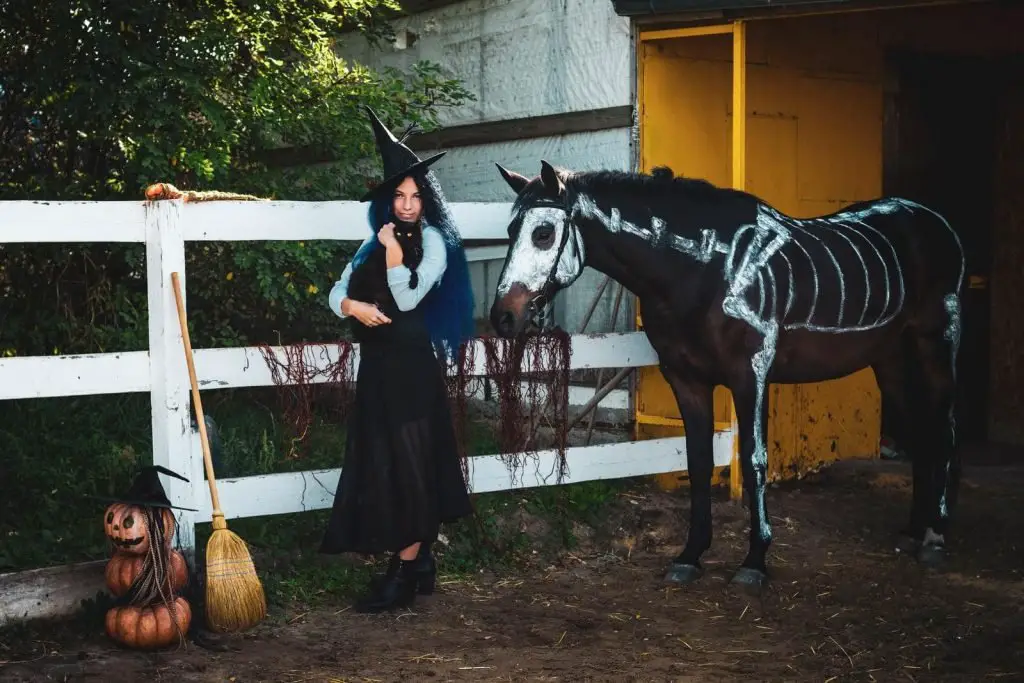
Prepare & Practice Your Skills
If you are painting for a demonstration or a costume contest then you will want to make sure that your painting skills are at least somewhat decent.
If you are artistically challenged you may want to practice painting your horse well before the big event.
Then when you paint your horse again you will know what worked, what didn’t and what you need to improve in your masterpiece.
8 Helpful Tips For Painting Your Horse
- You can do a quick test run and try using paint brushes with plain water and see how your horse handles it for a little while, before you decide to go out and buy the paints.
- Paint in the direction of the hair so that the paint stays on top of the coat and doesn’t go underneath, which may make it harder to clean afterwards.
- If your horse tends to get bored standing around for long periods of time, try tying up a hay net to keep him occupied.
- Set everything up in the area where you are going to paint your horse before you bring it over, so you are ready to go and your horse doesn’t have to stand tied up longer than necessary.
- Make sure the paints are in a secure location far enough away from the horse so your horse can’t bump into them, step on them, reach them, or knock the paints over.
- Don’t saturate the coat with paint because when you need to wash the paint off it will be much harder to get the paint to come off your horse.
- Always consider the weather before you paint your horse. If it is cold out, avoid getting your horse wet, as it can cause your horse to get sick.
- Most of these paints can be removed with water. However, if the paint is not coming out easily, try using a horse brush and soap such as dawn dish soap, which has been used by rescues on animals that have had oil in their fur or feathers, because it is gentle on them.
Horse Costume Ideas
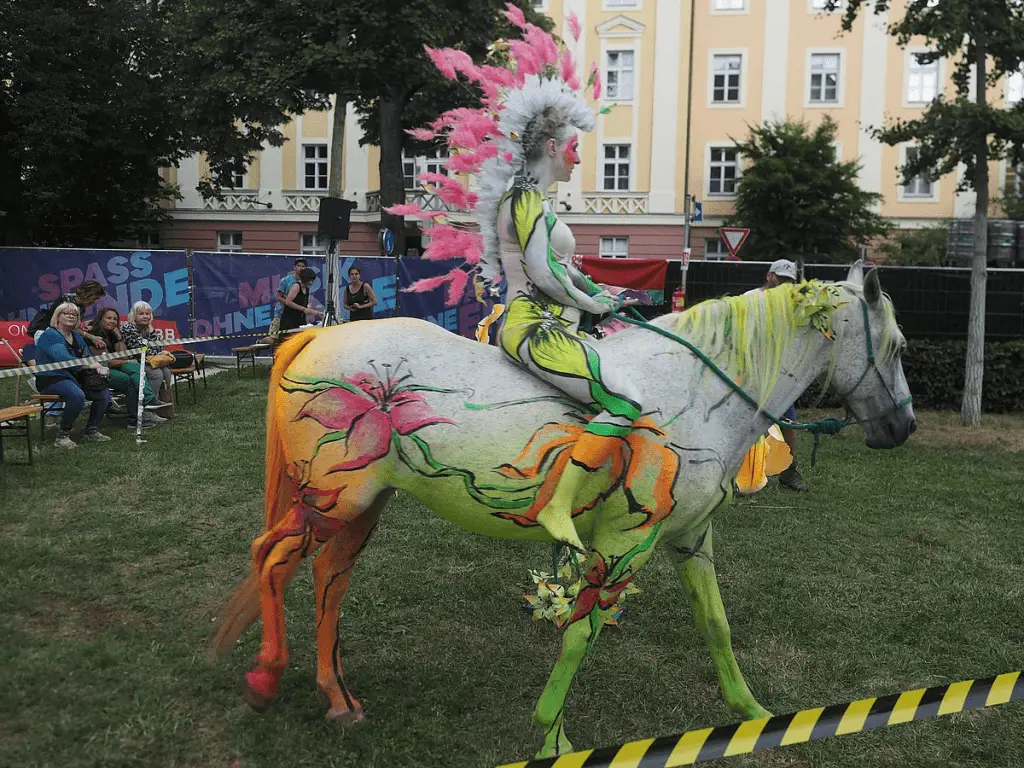
- Harry Potter Horse Costume:
- Rider: Dress as a wizard with a robe, scarf in house colors, and a wand.
- Horse: Outfit your horse as a Thestral or Hippogriff with crafted wings and a beak or eerie skeletal painting.
- Unicorn Horse Costume:
- Rider: Dress as a fairy with a flowy dress and wings.
- Horse: Attach a unicorn horn and mane extensions for that magical unicorn look.
- Prisoner:
- Rider: Don a black and white striped prisoner outfit with a cap.
- Horse: Design a ball and chain to gently hang by your horse’s side.
- Pumpkin Horse:
- Rider: Dress as a scarecrow with straw hat and overalls.
- Horse: Paint your horse orange or use an orange sheet, add a green mane/tail dye or extensions.
- Headless Horseman:
- Rider: Costume of a headless horseman with a cape and holding a pumpkin head.
- Horse: Dark, eerie attire, like a black sheet or cloak.
- Skeleton Horse:
- Rider: A skeleton costume with face paint.
- Horse: Paint bones with non-toxic paint or use a skeleton horse sheet.
- Witch Costume:
- Rider: Witch attire complete with a hat and broom.
- Horse: Paint spider webs or attach a witch’s hat.
- Zebra:
- Rider: Safari guide attire.
- Horse: As you suggested, paint white or black stripes; add an African-themed headpiece.
- Scarecrow:
- Rider: Farmer attire with a straw hat.
- Horse: Attach straw around its mane, tail, and some parts of its body.
- Superman or Wonder Woman Horse:
- Rider: Dress as Superman or Wonder Woman.
- Horse: Design a cape and emblem for your hero horse.
- Robot Horse:
- Rider: Dress up as a scientist or an alien.
- Horse: Use lightweight boxes painted metallic and secured safely to mimic robot parts.
FAQ’s About Painting Your Horse
Is Acrylic Paint Safe for Horses?
Acrylic paint is non-toxic, however it shouldn’t touch a horse’s skin. Depending on the hue and manufacturer, ingesting it may be deadly. Cancer-causing acrylic paint hues do exist.
Acrylic paints may be hazardous to horses, hence many people advise against using them. Never apply it on a horse’s head, since ingestion or skin contact is possible.
Safety first! Acrylic paint dries harder than washable paints.
Many painters who work with acrylic paint use gloves to avoid skin contact. Since there are non-toxic washable paints on the market, I wouldn’t use acrylic on horses unless you’re confident it’s safe.
Is Tempera Paint Safe for Horses?
Tempera paint is water-based. It is a creamy thin paint. It is also simple to combine and is non-toxic.
Tempera paints are completely safe to use on horses’ skin and manes, as well as dogs’ paws, since they are water-based. They are readily washable, so if they stain during painting, they will come off on your hands and clothing.
You can apply Tempera paint on your horse and wipe it off after a few days without leaving unappealing color.
Is Crayola Paint Safe for Horses?
The paint from Crayola is safe for horses. People use them for kids to finger paint with, which is a further sign that they are safe and won’t hurt anyone.
The Crayola brand has been around for long time, and their products are known to be safe for kids. Crayola products are safe for even young children who put everything in their mouths.
So you may safely use Crayola paint to make lovely designs on your ponies or horses.
Is Halloween Hair Color Sprays Safe For Your Horse?
You may also use hair color spray paints, which retailers begin offering around Halloween. Make careful you read the label and follow the safety precautions. You may also put it on their mane or tail, but bear in mind that it will take longer to fade if your horse has white hair.
Can I Paint My Horse’s Face?
You can find these paints online, which I think is the easiest option, or you can go to a store such as Michael’s, Walmart, or Joanne’s Fabrics, for example.
You can paint a horse’s face if the horse is comfortable and tolerant of you doing that. If the horse won’t tolerate face painting well, then you should skip painting your horse’s face.
You want to be really careful not to get the paint in your horse’s eyes, and it is best to just avoid painting near the eyes or the nose.
Is Painting Horses Cruel?
An opinion piece from Horse & Hound explains how upset people are anthropomorphizing horses in regards to their being painted as being abused. Painting horses is meant to be something light-hearted and fun, not abusive to the animal.
The horse doesn’t feel or think the same way that we do and they are not upset if they have color on them.
However if the horse was put in a paddock with other horses and the horse was fully painted and looked strange to the other horses. I could see that as a potential problem.
Maybe some of the horses might spook, or maybe some of the horses would be curious. Who knows how they would react.
Of course, some circumstances for painting horses are not ideal and could be considered bad practice, lack of care, or a safety hazard. Although horses are dangerous and unpredictable, you can only prevent so much.
Bad practices with painting horses would be:
- Using toxic paint that can hurt the horse.
- Crowding the horse with a bunch of people when the horse is not used to it or finds large crowds stressful.
- Making a horse stand for long periods of time is making the horse show signs of stress.
- The horse is not enjoying the process and is giving signals that they are not enjoying it. Such as horses that are sensitive and don’t even really enjoy grooming unless with soft brushes. The horse may not like the feeling of the wet paint.
- Sedating the horse to paint because the horse won’t stand still, as a precaution or doesn’t like it.
Pony Paint is a horse paint brand.
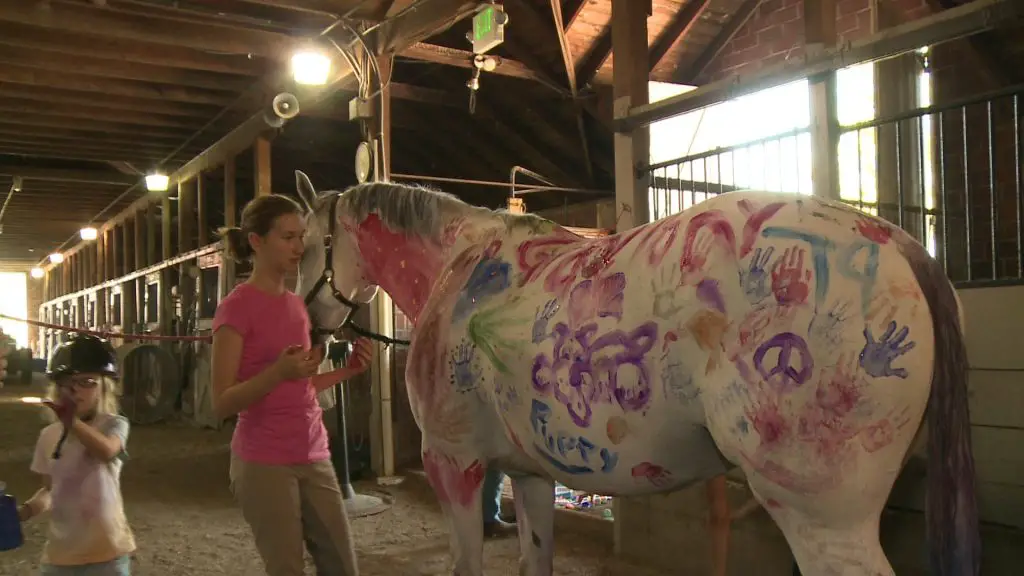
Conclusion On Painting Your Horse
Find a non-toxic washable paint so you are not harming your horse and the paint is easy to wash off.
Make sure your horse is comfortable with being painted on and standing for the process.
Have a plan or wing it and have fun!
But either way make it easier on yourself and the horse by setting up your area before hand and make sure you are painting your horse in a relaxed calm place.
Have fun and be safe!
Would love to hear about your painting experience with your horse in the comments.
What did you paint on your horse?
Cheers, Kacey

